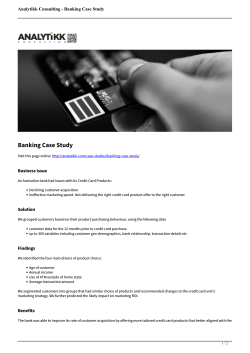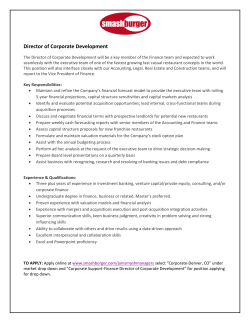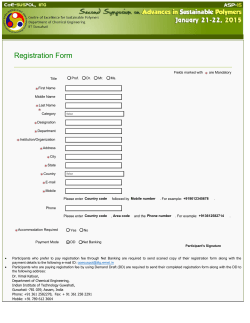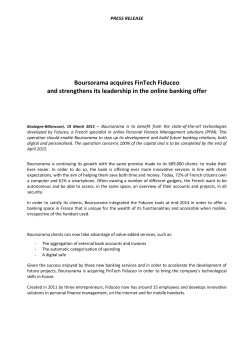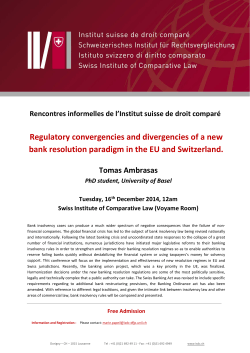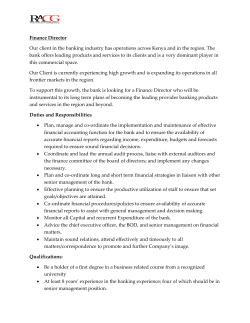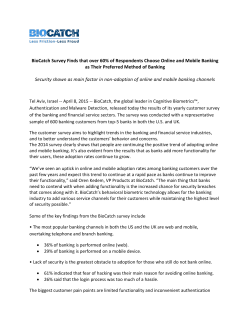
Risk Analysis in Banking Industry
Risk Analysis in Banking Industry Koushik Karmakar Asst Professor, Dept of CSE, Narula Institute of Technology, Kolkata Abstract: Banking industry plays a very vital role in countries economic development and is also the major backbone of the economic structure. In INDIA, this industry is run by both government and private partners under the strict surveillance of “Reserve Bank of India (RBI)” and different other government agencies. But, this vital backbone sometimes becomes victims of different frauds and as a result incurred huge losses. Actually, it suffers from risks of different kinds. In this article, I tried to find out the risks associated with this banking industry. Keywords: Risk analysis, user’s risk, banking risk. I. INTRODUCTION Banking industry plays a very vital role in countries economy and the major backbone of the economic structure. In the last few years, role of the banking sector also changes a lot. It can be divided into different types like Scheduled Commercial Banks, Regional Rural Banks, and Co-operative Banks. It performs multiple functions like satisfying the financial needs of industries, trades, agricultures and other important sectors. Some of the needs for credit are satisfied by different non-Banking Financial Institutions and different self help groups. Among the different tasks performed by these banking sectors are, accepting deposits from its clients and paying them after a certain interval with a fixed rate of interests, providing loans to its customers, cheque clearance, sale of shares, mutual funds, government bonds, money transfer, accepting money for different challans and receipts and other important monetary transactions. II. RISK ANALYSIS The word “risk” means a situation involving exposure to danger. It refers to the probability or threat of damage, liability, loss or any other occurrence caused by some external or internal activities. It is the potential that a chosen action or activity will lead to an undesirable outcome including loss. Possible losses may be termed as “risks”. Every individual activity may cause some risks but some activities are much more risky than others whereas some are less risky. It may cause a lot of harms if the risks become true and therefore its detection, assessment and plans for mitigation is absolutely necessary. Risk management includes all these activities. It consists of identification of the risks, asses them and appropriate plans is made to curve them. Risk management is therefore very important in all the industries. In the following section potential risks in Banking Industries have been identified and discussed. III. RISK ANALYSIS IN BANKING INDUSTRY Global risks in the banking industry are a very important issue in the recent years. After the recent global financial crisis it has become much more important. Also the regulating bodies imposed new rules to tackle the crisis. In the recent years therefore obeying these rules have become major tasks. Risks analysis has a very vital role here as it helps bring stability of the entire system and run it smoothly. Risk management, in the banking business, mainly gives emphasis on risk weighted and regulatory review driven capital adequacy, exposure norms, provisioning norms, credit rating, governance etc. But, only obeying the rules and regulations doesn’t necessarily ensure a good banking business but also sometimes may be a bottleneck in the long run. The best approach for the banking industry is to analysis itself and accordingly frame new rules so that it gets a major market share, run its business smoothly as well as obey all the rules and regulations. “Risk” associated with this industry can be divided into mainly two different types. First type risk deals with the risk for users of the banking system whereas the second type deals with the risks associated with the banking business itself. a. Risk for users: Users of the banking system may face two different risks: i. It deals with the risks that the payment will reach to its clients properly and in time. ii. Another risk is associated with the payment system of the bank. The system should remain in place for a long time so that the ability to move funds remains viable and also the system remains stable. b. Risk for banking business: Another type of risks is associated with the banking business itself. It deals with various types of activities and deals with different range of clients. Banking system also is divided into different types and segments. In day to day activities of the banking system, any mistake and error and mismatch between the facts and the actual data may lead to a lot of problems. It is larger risks for this industry. In the following section they are described in details: i. Legal risk: It deals with the risks associated with the settlement process. Any legal dispute regarding the banking system may create a lot of problems and as a result of which the business may hamper a lot. Therefore, all the rules should be defined very clearly. All the activities also therefore must be transparent as well as well defined. There should be no confusion of any kind for its interpretation. ii. Liquidity risk: It is another vital part of this system. Banks must maintain sufficient cash so that it can maintain the needs of all the customers at a time without any problem. An assessment regarding the market liquidity must be done properly. Liquidity can handle a crisis situation. iii. Credit risks: Managing credit risk is another important aspect of this industry. With a higher level of confidence, banking sector should handle the credit requirement of every customer. It must have a close vigil to its credit exposure and other related issues like repayment, settlements etc. iv. Default risk: In the settlement process default has a larger impact. It can hamper the stability and smooth running of the system. Rules should be clear and mention properly so that looses do not incur. Entire process should be fully transparent. v. Settlement process risk: Settlement related issues should be taken with utmost care. Accuracy and complete transparency should be maintained. Any kind of credit and liquidity risks should be handled with properly. vi. Investment risks: Another important risk in this business is the risks associated with investments. Margins are collected from different sources and they are invested. Entire process must be transparent and for that monitoring is required properly. vii. Segregation and portability: Sometimes the participants suffer losses because of a failure of investments at a proper proportionate rate. It may have larger impacts on the entire system mainly for the medium and smaller organizations. viii. Interdependences: It is of another risk type. Central counter-parties works with other parties. Any parties may fail and therefore it poses a larger thread. Even it can pose similar risks to others also. It needs careful monitoring. ix. Operational risk: It includes different types of risks like fraud, operations failure, natural disasters etc. When the processes of a system runs properly, the entire system also run smoothly. This is also applicable in banking system also. Even if failure occurs, it should recover without any delay. Main threats should be identified and appropriate plan for its mitigation should be taken so that the system can run without any interruption. x. Market risk: One of the significant areas of risk management needs to handle is market risk. Any types of business largely dependent on the market. Market study and its risk analysis are therefore very important and appropriate plans for its mitigation are required as the banking business is also dependent largely on market conditions. xi. Risk of loss of reputation: Reputation of any organization plays a significant role in business. Loss of reputation is a major thread to business. To avoid the risk of losing reputation, appropriate risk management plans should be prepared. External perceptions of the bank should be regularly measured. Reputational threads should be systematically tracked. Employees should be trained to identify and manage reputational risks. xii. Fraud Risk: Fraud risk is one of the major threats in any business and industry. It has a larger impact in the in the financial sectors. Frauds mainly occur in the area of retail business, loans, internet banking etc. It also occurs in the traditional areas of banking. Different types of frauds that affect the banking industry are as follows: a. Accounting fraud: In this type of fraud, accounting and financial documents are falsified. It includes accounting manipulations, fraudulent application for credit and unauthorized transaction, fraudulent borrowings, rising of finance etc. b. Bribery and corruption: Due to the bribery and corruption 40% of the frauds take place. Bribes in the form of cash or gifts can be given. Weak law enforcement and absence of effective regulatory and compliance facilitates corruption. c. Cyber crime: It includes spreading viruses, illegally downloading files, phishing and pharming and stealing personal information like bank account details. It is a major source of frauds with the increase of e-business, internet and e-commerce. d. Asset misappropriation: It has become most common types of economic crime nowadays. An increase in asset misappropriation takes place between 2007 to 2011. Main examples of asset misappropriation are fraudulent disbursements like billing, payroll schemes, expense reimbursement, cheque tampering, cash register disbursement schemes etc. IV.CONCLUSION Risk analysis is very important for any industry especially important industry like banking and financial sector. Possible risks should be analyzed with utmost care and appropriate measures should be taken. Unless proper measures are taken, there is chance that this important sector may be the victim of frauds of different kinds. As a results of which, huge losses may incur. It will be a major threat for the people associated this industry. In fact, in the modern world, every class of people of the society is dependent on this sector and none can deny the impact of banking in their life. Therefore, risk analysis and their appropriate mitigation techniques are the most important need of the hour. REFERENCES [1] [2] [3] [4] [5] [6] [7] [8] [9] [10] [11] [12] [13] [14] [15] B HUANG, Q ZHANG, Y HU, “RESEARCH ON CREDIT RISK MANAGEMENT OF THE STATE-OWNED COMMERCIAL BANK”, Proceedings of the Fourth International Conference on Machine Learning and Cybernetics, Guangzhou, 18-21 August 2005. C Atkinson, C Cuske, T Dickopp, “Concepts for an Ontology-centric Technology Risk Management Architecture in the Banking Industry”, 10th IEEE International Enterprise Distributed Object Computing Conference Workshops (EDOCW'06). M Jibin, C Yi, “Research on Risk Management of Bank Loan and Loss Provision Based on Markov Chain”, IEEE 2009. L. Bo, X. Congwei, “E-commerce Security Risk Analysis and Management Strategies of Commercial Banks ”, 2009 International Forum on Information Technology and Applications, IEEE Computer Society, DOI 10.1109/IFITA.2009.92. S F Zhao, L C Chen, “THE BP NEURAL NETWORKS APPLICATIONS IN BANK CREDIT RISK MANAGEMENT SYSTEM”, Proc. 8th International Conference on Cognitive Informatics (ICCR09), IEEE2009. K G Chun, “RESEARCH ON COMPLETE RISK MANAGEMENT OF CHINESE COMMERCIAL BANKING BASED ON THE NEW BASEL CAPITAL ACCORD ”, IEEE Computer Society DOI 10.1109/ICCTD.2009.266. S A Sherer, “Accessing the Risk of Software Failure in a Funds Transfer Application”, IEEE 1992. J C Paradi, C Marr, M Wong, G Yan, “Simulation Based Alternative Strategies in Risk and Service Guarantee Tradeoffs in the International Funds Transfer System at a Large Canadian Bank”, IEEE TRANSACTIONS ON ENGINEERING MANGEMENT, VOL. 42, NO 4, NOVEMBER 1995. S Qu, Y Zhang, “The Strategy of the Operational Risk Management: Connotations of it in Commercial Banks of China ”, 2012 Fifth International Conference on Business Intelligence and Financial Engineering, 2012 IEEE DOI 10.1109/BIFE.2012.51. S Qu, Q Zhang, “Analysis of the Relationship between the Employee Training and the Level of the Risk Management of Village Bank in China”, 2011 Fourth International Conference on Business Intelligence and Financial Engineering, IEEE Computer Society, DOI 10.1109/BIFE.2011.21. S Roy, “Payment & Settlement System Risk Management”, The Journal of Indian Institute of Banking and Finance, page. 21-26, Vol. 83, No. 3, July-Sep’2012. A Gupte, “Fraud Risk Management”, The Journal of Indian Institute of Banking and Finance, page. 28-31, Vol. 83, No. 3, July-Sep’2012. N. K Bhasin, “Managing Banking Risk Through Ideal Technology”, The Journal of Indian Institute of Banking and Finance, page. 36-42, Vol. 83, No. 3, July-Sep’2012. A. J. D. Thangaraj, G Panicker, “The Invisible Bottom-line”, The Journal of Indian Institute of Banking and Finance, page. 13-20, Vol. 83, No. 3, July-Sep’2012. X Ying, “A study on Risk Management Technology of Commercial Banks”, IEEE2011.
© Copyright 2025
